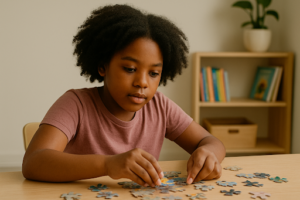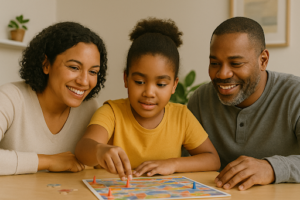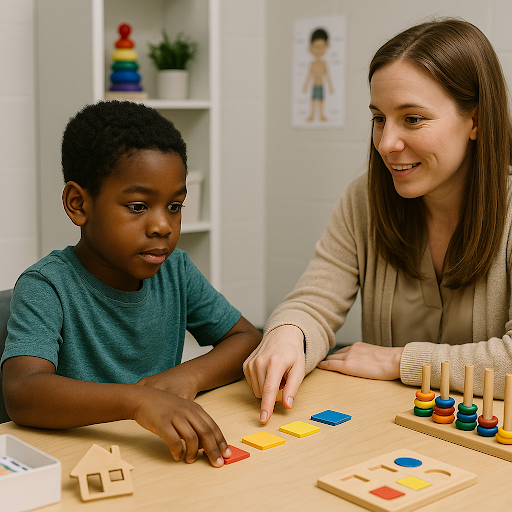As kids outgrow age 7, ABA therapy changes into a more playful and interactive approach. It’s out with the structured drills and in with games, conversations, role play, and real-life moments, which we bring into your everyday family routine.
To ensure the success of this shift, therapists establish trust by presenting themselves as not only a therapist but also a friend and mentor before beginning any instruction.
In this tutorial, we will walk you through the changes in ABA behavior analysis that are related to growth, including how goals alter, how sessions adapt, and how what was once a structured session has evolved into a warm moment full of opportunity.
It doesn’t have to feel like therapy but rather just another part of life, like sharing in a laugh at the table or an impromptu dance in the living room.
Also in this journey, which we travel together, the focus is on your child’s strengths, your family’s rhythm, and the celebration of everyday successes.
Growth And Changing Needs
Basic interaction, association, and simple rituals. Once in school and social groups that form, the goals tend to change to more complex and meaningful ones.
1. Moving from basics to building the bigger picture
Parents often notice this evolution: all of a sudden, what we see is a shift away from greeting or naming colors to issues of navigating friends, doing homework on their own, and dealing with big emotions when things fall through.
Research has shown that applied behavior analysis significantly improves cognitive, social and emotional, and even academic skills in school-aged children with autism and developmental abnormalities.
2. The worry of ‘Is my child too old for ABA?’
ABA grows with the individual. We see from the research that when children are put through applied behavior analysis during their school years, they see progress in emotional regulation, peer interaction, and academic skills.
Also, parents’ role is very much a key and constant element, from helping with homework to being that supportive figure at the sports field.
3. Key pillars of ongoing ABA support: the school–home–community triangle
ABA works best when integrated into your child’s daily routine in three settings:
| Environment | ABA Pillar | Examples of Focus |
| School | Peer/social skills & academic success | Turn-taking games, group activities, and classroom routines |
| Home | Self-care, independence, and homework routines | Morning routines, chore checklists, and emotional check-ins |
| Community | Real-world competence & confidence levels | Role-play in stores, playground rules, and after-school clubs |
We integrate ABA into all parts of school, home, and community life, and we provide constant staff training. Thus, growth is more than just compliance or skill acquisition; it is about confidence, joy, and easy transitions.
What to Expect in ABA as Your Child Ages 7+
At the age of 7 and beyond, ABA therapy takes on a different aspect, which is of a more real-world application as opposed to what we see in the early years, which is very structured around drill work.
Here is an in-depth, research-based look at what you can expect:
1. Deeper Skill Domains
- Self-Regulation & Emotional Intelligence: At present, what is seen is that children are developing emotional mastery. We see that they use tools like emotional thermometers, quiet areas for de-escalation, and short break strategies. Also, we note from research that reports on school-age ABA participants report very good improvements in social and emotional functioning.
- Academic Readiness & Executive Functioning: ABA focuses on memory, sustained attention, organization, and homework routines through the use of behaviorally based supports. In studies, it is reported that ABA principles are put into the school setting, which in turn improves academic engagement.
- Peer & Social Skills: Therapists progress from simple turn-taking to more complex social skills such as initiating friendships and declining pressure. We notice that class-wide peer tutoring empowers children through peer modeling and inclusive social environments.
2. Advanced Treatment Methods
- Video Modeling & Self-Modeling: Showing kids videos of other kids (or themselves), which is a part of social situation navigation, prompts imitation and retention. Also, we have meta-analyses that report that, via video, dramatic improvements in conversational, play, and daily living skills are achieved.
- Natural Environment Teaching (NET): Learning is embedded in daily activities such as using polite requests at the dinner table or waiting for turns at the park. It also improves generalization and engagement.
- Community-Based Instruction (CBI): Therapists take kids to cafes, playgrounds, and local shops to work on social skills, money skills, and standing in line. At the same time, they increase the child’s competence and confidence.

3. Enhanced Child-led Engagement
By the age of 7+, children take up leadership in therapy.
- Choice-based Learning: Kids choose between activities, set small goals, and self-monitor.
- Intrinsic Motivation: Reinforcers shift from generic tokens to very personal items like favorite hobbies, games, or positive feedback from peers.
4. Broader Support Team
The intervention team strengthens in scope:
- BCBAs lead design and oversight.
- RBTs implement daily sessions.
- Peer group facilitators or social coaches may run clubs or group therapy.
- School Staff Collaboration: Teachers use tactics such as token systems and the Good Behavior Game (GBG) for self-regulation and attention control in class.
5. Functional & Contextual Goals
ABA goals take on practical relevance:
- Homework Routines: Structured checklists, timers, and rewards that support transitions into independent habits.
- Social Confidence: Through role play, kids practice reaching out to join in play, sharing space, or putting forth their disappointment.
- Life Skills: From buying lunch at a cafe to putting together their school bags, kids learn how to handle the tasks of the day.
6. Family Engagement & Progress Monitoring
- Visual Tracking Tools: Parents track progress in charts and dashboards for behaviors and goals.
- Data-Informed Meetings: Weekly and monthly updates that fine-tune strategies.
- Collaborative Planning: Parent feedback is used to tailor interventions to what works at home and what is difficult at school.
Why This Approach Works
- Evidence-Based: Technological tools such as video modeling, generalization, and community-based instruction are supported by peer-reviewed research for school-age kids with ASD.
- Generalizes to Everyday Life: In real-world settings, skills stick.
- Sustainable Growth: When skills are part of everyday activities, children not only learn but also do very well.
Family, School & Community Factors
As your child begins his ABA journey at age 7+, he is not just to learn new skills but is instead a part of a network that includes family, teachers and the real world. How we implement expert-level ABA at this stage is to have it flow smoothly through these areas.
Home: Making Therapy Belong
According to research, parents who receive ABA training do better, as do their children. That might be anything from assisting with morning routines to creating behavior contracts for assignments; you play the role of co-therapist, which is to reinforce what they learned in sessions while also putting it into action.
You are, in reality, the key to translating what is learned in isolated situations into real-world growth.
School: Partners in Success
Center-based ABA services improve in areas such as communication, attention, and social skills, which we see especially when therapists team up with teachers, and we see IEP goals being included.
We have a study that shows that persistent ABA in school for 25-40 hours per week generated excellent results, including improvements in attention, memory, language, and peer interactions.
Furthermore, we demonstrate that tactics such as token systems, social storytelling, and even big group strategies like the Good Behavior Game perform admirably in terms of generalization and inclusion.
Community: Beyond the Classroom
True expertise is when skills leave the school and home setting. In the community-based ABA, or community-based instruction (CBI), we see kids put into practice real-world skills like ordering food, queuing up, or joining groups.
This immersion into the community builds independence, belonging, and self-confidence. We also see community integration, which improves social competence and quality of life for school-aged kids.

How These Pillars Fit Together
When we apply behavior analysis to these three environments:
- Morning and evening routines, homework assistance, and problem-solving are also provided at home.
- The school emphasizes academic preparedness, attendance, and classroom behavior.
- Community teaches life skills through real-world experience.
This group of elements demonstrates that our emphasis is not confined to what we learn in a therapy room. Instead, these abilities are integrated into your child’s daily life, allowing them to perform better in social situations, normal tasks, and dealing with new challenges that arise.
How Willow Reach ABA Brings Real-World Value
Willow Reach ABA distinguishes itself by offering ABA treatments that are opposed to formal therapeutic settings.
Sessions That Fit Into Your Life
In-home ABA therapy includes applied behavior analysis and daily activities such as snack time, chores, or homework, which reduce stress and reinforce skills in the setting that is most relevant to the child.
Centering-based therapy provides structured settings for the development of specific skills, which is great for kids as they prepare to use those skills in the community or school setting.
Parent Empowerment & Everyday Consistency
Parents are not on the periphery; they are partners in the process. BCBAs work with caregivers to do in-depth ABA training; we show how to put easy strategies into practice at the breakfast table, at the park, and in the middle of sibling play, which makes the learning continuous across all settings.
Real-World Practice Beyond the Home
Willow Reach ABA integrates applied behavior analysis into public settings, which include grocery stores, playgrounds, and libraries. We plan these excursions as a live practice of social, communication, and life skills.
Final Thoughts
ABA is not a set program that you finish; we present it as a toolbox that grows with your child’s world.
Also in this is the input of caregivers, who do what they do based on applied behavior analysis; therapists, who support autonomy; and community settings, which celebrate each step. What we put together is a safety net of evidence and emotion.
Snack time, work completion, and the first confident steps into a new camp are not just everyday occurrences. They are the emerging futures of each day, in which we participate one at a time. In each of those moments, our support, advocacy, and love are the driving forces behind the scenes, transforming what could be into what is.
Frequently Asked Questions Related To ABA Therapy (FAQs)
- How can I stay involved in my child’s ABA sessions without disrupting therapy?
Your role is dependent on the goals specified by your BCBA. It’s helpful to ask ahead of time, “Would you like me nearby, or should I step out during data collection?” Being available but not intrusive promotes rapport and growth without distraction.
- What parent training should I expect in school-age ABA?
Weekly and monthly coaching for parents is a very common practice. We will present to you strategies that are tailored to your family’s routine for managing transitions better, using visual supports more, or improving emotional regulation at home and in school.
- Can ABA be effective even if my child starts at age 7 or older?
Yes, ABA has lasting effects into the school-age years. In that time, we see growth in independence, social skills, and life skills, which may be achieved with fewer intensive hours.
- How does Willow Reach ABA support community integration?
Willow Reach ABA emphasizes practical learning outside of treatment rooms, assisting children on field trips to playgrounds, stores, and libraries. Our therapists actively teach skills such as ordering, turn-taking, and peer greetings in real-world settings. This improves generalization and allows children to navigate daily life with greater confidence.
- What credentials do Willow Reach ABA therapists have, and why does it matter?
Willow Reach ABA employs certified professionals: BCBAs design programs, and RBTs implement them. In forum discussions, parents stress that it is the RBT’s experience that counts. Ask your provider what they do for ongoing mentor support, supervision and training. The 1-to-1 clinician-to-child ratio also includes trained supervision, which leads to more personalized and effective ABA care.
For tips, success stories from experience and expert information on ABA therapy for school-age kids, follow Willow Reach ABA on Instagram and Facebook and join a community that is right there with you on your journey.
